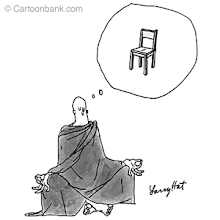
This painting on a hanging silk scroll was done of an unidentified Obaku monk. Such portraits hung in the halls of monasteries. This one is from the 18th or 19th century.
An exhibit opening Sept. 15 at the University of Tennessee's Frank H. McClung Museum explores Zen and art...

An exhibit opening Sept. 15 at the University of Tennessee's Frank H. McClung Museum explores both the simple yet elegant beauty and the deeper meanings of art developed around Zen Buddhism.
The display includes such objects as tea bowls, robes, bronze memorial plaques and a wooden sculpture of the guardian figure called Fudo Myoo. "Zen Buddhism" also shows more than 40 hanging scrolls whose paintings and calligraphy were created by Zen Buddhist monks from 1600 to 1868.
The beliefs and practices of Zen Buddhists were the motivation for the works of art. The items were used by those who practiced the religion and also reflected aspects of it.
Zen is one of many schools of Buddhism, the religion founded more than 2,000 years ago by Siddhartha Gautama, commonly known as the Buddha.
Zen art is known for its elegant simplicity. Many of the paintings and calligraphies in the exhibit are done in black ink on white silk or paper.
The images were created as expressions of enlightenment. The works also were considered forms of meditation as they were created and objects of meditation after they were finished. Their artists were Zen masters who were teachers and often abbots of monasteries, says in information about the exhibit,
Buddhism spread from India to China. According to Zen legend, the Indian monk Bodhidharma introduced a new school of Buddhism to China between 420 and 589. That form of the religion was called Chan in China and Zen in Japan, where it became the dominant form of Buddhism by the twelfth century. Seated meditation or zazen is the core practice of Zen Buddhism.






No comments:
Post a Comment